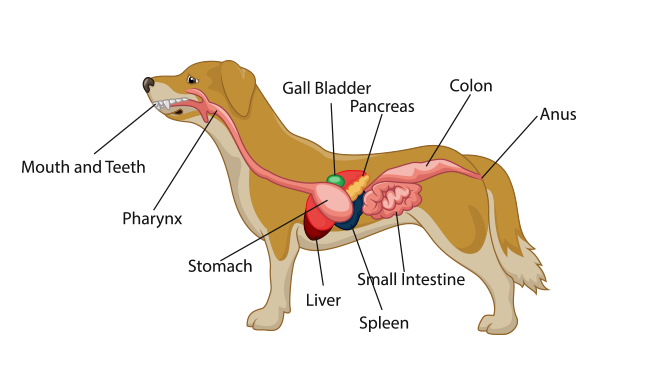Pancreatitis in dogs
When a good little organ becomes a monster
What is the pancreas?
The pancreas is a relatively small, pale pink glandular organ that sits alongside the duodenum (upper small intestine) and the stomach.
It makes hormones (such as insulin and glucagon) that go into the bloodstream and regulate blood glucose. And it makes enzymes that end up in the duodenum. where they digest food. So, the pancreas is part endocrine organ and also part of the digestive system.
Let's take a quick tour of the digestive system so we can better understand how the pancreas fits in.
First, your dog takes a mouthful of food. The food is chewed (or not if you've got a Labrador) and mixed with salivary enzymes. The food is moved to the pharnyx where it is swallowed. Swallowed food moves down the oesophagus and within seconds enters the stomach.
In the stomach the food is broken by both stomach movements and the stomach juices. Once the food is mooshed up enough, it can enter the small intestine.
The first part of the small intestine is the duodenum. Here the food is further broken down and digested by enzymes that come from the pancreas. As the digested food moves along to the lower small intestine, nutrients are absorbed.
Then finally everything moves into the large intestine (colon) where water is aborbed and stools are formed and stored before being eliminated.
Now back to those pancreatic enzymes...
The pancreas makes inactive (harmless) forms of the enzymes. The enzymes need to be activated to work (ie digest food) and activation should only happen within the intestines, where it can be done safely and no damage any tissue.
But activation can happen in the pancreas itself. If that case, the enzymes basically treat the pancreas like it's food and digest it. Not good.
What is pancreatitis?
Pancreatitis means inflammation of the pancreas. It occurs when the pancreatic enzymes are activated in the pancreas and they start to digest it and the surrounding tissues. Once activation is started, it tends to go off like bomb.
This 'auto-digestion' causes swelling of the pancreas and release of inflammatory toxins. These can rapidly affect nearby organs and tissues (eg small intestine, stomach, liver and body fat).
If the inflammatory process continues, organs and tissues further away can be affected (eg kidneys, lungs and even the brain).
Pancreatitis can be acute or chronic and mild or severe. Dogs tend to get acute pancreatitis, whereas cats more commonly get chronic pancreatitis. The severity varies a lot. Mild cases may not need any treatment at all. Severe cases may need to be managed in an intensive care unit (ICU).
What causes pancreatitis?
So what causes the pancreatitic enzymes to be activated in the pancreas? Well, we know that pancreatitis may be triggered by things like:
- a very fatty meal – this can stimulate release of pancreatic enzymes that digest fat
- trauma to the pancreas (eg car accident)
- some drugs (eg trimethoprim sulpha antibiotics, azothioprine, potassium bromide, steroids – this last one is controversial as studies say know but clinical experience says yes)
- reflux of duodenal juices (containing activated enzymes) into the pancreatitic duct
- pancreatic tumours
Miniature Schnauzers are at greater risk of pancreatitis than other dogs because of the way they metabolise fat.
In most of the cases of pancreatitis that we see, there is no obvious cause suggesting there are triggers that we don't understand yet.
What are the signs of pancreatitis?
The classic signs of pancreatitis are:
- vomiting
- going off food
- abdominal pain (which shows as reluctance to move; a belly that's tense and tender to touch; hunched appearance; digging holes and lying in them; hiding)
- diarrhoea
- fever
Not all signs are present in all cases.
How in pancreatitis diagnosed?
Pancreatitis can be diagnosed by:
- standard blood testing – can suggest pancreatitis, for example if we see high white cells, high lipase and amylase (pancreatic enzymes) and elevated liver enzymes in a dog with vomiting and abdominal pain, we can be very suspicious of pancreatitis
- specific pancreatic lipase testing – this is much more accuate than the lipase of standard testing. A negative test rules out pancreatitis, and a positive test probably means pancreatitis is present
- ultrasound – the accuracy of ultrasound is dependent on the person doing the scanning, but is can be very useful in both diagnosing pancreatitis and looking at surrounding organs and tissues
- surgery – in some cases surgical exploration is the only way to make a correct diagnosis
How is pancreatitis treated?
There is no single medication that treats pancreatitis.
Treatment of pancreatitis typically involves:
- IV fluids to rehydrate the patient and support the circulation (allowing healing to occur)
- pain relief
- anti-nausea medication
Plasma transfusions are sometimes used.
In the past we used to fast patients with pancreatitis for several days. We no longer do that. Once vomiting and nausea is controlled, we start offering food and water. The earlier we can get dogs eating again, the better they seem to do. And the earlier they can go home.
We use low fat foods when managing pancreatitis and some dogs need to stay on low fat food for life.

